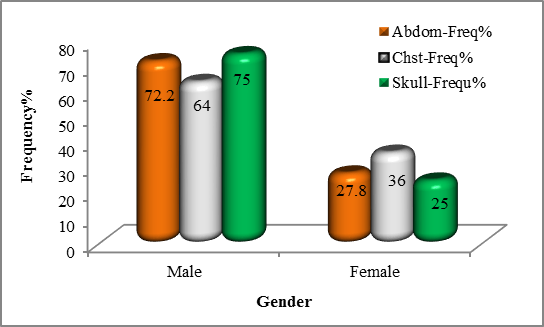
Abdulrahman A. S. Alsayyari
Qassim University, Saudi Arabia
Title: Study of common requested radiographs and relative exposure dose in Qassim province
Biography
Biography: Abdulrahman A. S. Alsayyari
Abstract
The objective of the article was to study the common requested radiographs and relative exposure dose in Qassim province in Kingdom of Saudi Arabia. The method was retrospective and analytical study for collected variables as radiographs, relative entrance surface dose (ESD) and the effective dose, patient age, gender and causative factors. The doses have been derived from the product of system output, mAs, back scatter factor BSF, focal detector distance FDD and focus – skin- distance FSD based on the equation stated by ICRU, (2005) and Davies et al, (1997):
The objective of the article was to study the common requested radiographs and relative exposure dose in Qassim province in Kingdom of Saudi Arabia. The method was retrospective and analytical study for collected variables as radiographs, relative entrance surface dose (ESD) and the effective dose, patient age, gender and causative factors. The doses have been derived from the product of system output, mAs, back scatter factor BSF, focal detector distance FDD and focus – skin- distance FSD based on the equation stated by ICRU, (2005) and Davies et al, (1997):
Dose (mGy) = (Output(mGy⁄mAs)×(mAs)×(BSF)×〖(FDD)〗^2)/〖(FSD)〗^2
Then the effective dose in mSv has been derived from the equation stated by ICRP, 2007 report 103.
EffD= ∑(W_T [H_T (female)+ H_T (male)])/2
Where WT refers to weighting factor for organ or tissue and HT refers to equivalent dose to organ or tissue.
The analysis with excel software revealed that: the common requested radiographs were skull, abdomen and chest with male incidence as 75%, 72.2% and 64% respectively relative to whole sample. Traffic accident (71%) and fall-down (45%) were the most causative factors among male, female respectively, with injuries as skull fissure fracture (77%), and intracranial hemorrhage (23%). The skull radiographs noted among the age group of 11-21 years and peaking at 36% among the age group of 22-32 years. The requested abdominal radiographs appeared among the age group of 13-21 years; with frequency of (19%) and peaking at 30% among the age group of 22-30 years; with injuries as spleen ruptures (42%) and liver (27%). The chest radiographs observed among age group of 3-13 years; with frequency of 4% and peaking among age groups of 14-24 & 25-35 years old with frequencies of 19% and 21% respectively, and injuries as ribs fracture (55%), ribs dislocation (15%), pierced lung (20%) hemorrhage (10%). The average ESD for abdomen, skull and the chest radiographs were 1.93±0.8, 1.53±0.6 and 0.21±0.2 mGy, which were increase linearly following the aging, and the average effective doses were 0.24±0.1, 0.1±0.1 and 0.4±0.2 mSv respectively.
Image :
 Figure 1: shows distribution of requested radiographic based on gender
Figure 1: shows distribution of requested radiographic based on gender
Figure 2: shows the distribution of requested radiographic cases based on causes
Figure 3: shows the average ESD in mGy & EffD in mSv received by common anatomical site radiography
Recent Publications
1. Kristin B Lysdah and BjÙ‘rn M Hofmann. (2009). What causes increasing and unnecessary use of radiological investigations? A survey of radiologists' perceptions. BMC Health Services Research, 9:155. doi: 10.1186/1472-6963-9-155.
2. United Nations Scientific Committee on the Effects of Atomic Radiation. (2000). Sources and effects of ionizing radiation: report to the General Assembly, annex D, medical radiation
3. ICRP. (1991). Recommendations of the ICRP publication 60, Annals of ICRP, Pergamon Press, Oxford.



